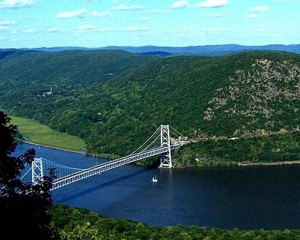
Regional talk of bridges usually gravitates toward the Tappan Zee, a sturdy headline generator across the years for its traffic and for its punch holes.
But the 58 million annual travelers across the New York State Bridge Authority”™s five Mid-Hudson regional bridges “can rest assured that these bridges are well maintained and safe,” according to the agency charged with operating them.
The spans are the Bear Mountain Bridge, Newburgh-Beacon Bridge, Mid-Hudson Bridge, Kingston-Rhinecliff Bridge and Rip Van Winkle Bridge. More than 58 million vehicles (159,000 cars per day) crossed the five bridges in 2010.
The Tappan Zee is operated by the New York State Thruway Authority. It carries as many as 170,000 vehicles per day ”“ 140,000 is average. It was designed to carry 18,000 vehicles per day.
Opened in 1924, the Bear Mountain Bridge is the oldest of the five. It was built for $2.9 million; in 2008 its replacement cost was estimated to be $122.13 million. It, like its four cousins, is inspected annually, which is twice the level of inspection required by law, the authority reports.
“We”™ve received a few calls asking about bridge safety; so we want to assure our customers that our bridges are well-maintained, safe and in very good condition,” Bridge Authority Executive Director Joseph Ruggiero said in a statement. He said that each bridge receives a full inspection every two years under federal and state guidelines, but noted the Bridge Authority goes a step further by having that inspection report updated every year.
Authority Chairman James P. Sproat said the authority takes a great deal of pride in its programs. “We constantly reinvest toll revenues into our facilities and have an aggressive long-range plan to ensure continued safe operation of these critical bridges.”
All five bridges received a rating of “5,” the highest rating that can be achieved for the older bridges that the authority owns.
“Our maintenance programs are proactive, address concerns and look to the future before we have major problems,” Ruggiero said. “With several of our bridges approaching a hundred years old, the diligence we apply to maintenance is even more critical to make sure our bridges continue to provide safe and reliable service.”



















